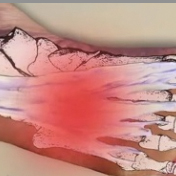 About once a week, the Natural Running Center will receive an email from a reader complaining about chronic plantar facsiitis pain in his or her foot. For these sufferers, conventional treatment ranges from orthotics to NSAIDS, neither of which are natural methods or recommended. Nor are they effective. These readers are looking for answers. Maybe “looking” is too soft of a word. They are begging for a life without foot pain. You can sense their desperation in their emails. Well, relief and help are finally here. In this video, Natural Running Center good friend and Correct Toes founder, Dr. Ray McClanahan DPM, will help all runners better understand the foot and plantar facsciitis. The video came out several years ago, but it’s golden oldie and one worth watching and sharing. And see Dr. Ray’s article on pf on the link below.
About once a week, the Natural Running Center will receive an email from a reader complaining about chronic plantar facsiitis pain in his or her foot. For these sufferers, conventional treatment ranges from orthotics to NSAIDS, neither of which are natural methods or recommended. Nor are they effective. These readers are looking for answers. Maybe “looking” is too soft of a word. They are begging for a life without foot pain. You can sense their desperation in their emails. Well, relief and help are finally here. In this video, Natural Running Center good friend and Correct Toes founder, Dr. Ray McClanahan DPM, will help all runners better understand the foot and plantar facsciitis. The video came out several years ago, but it’s golden oldie and one worth watching and sharing. And see Dr. Ray’s article on pf on the link below.
More here: https://nwfootankle.com/foot-health/drill/2-articles/121-plantar-fasciosis


I am a mild pronator and normally wear Brooks Ravenna stability shoes. If I were to buy these CorrectToes can I wear them with my stability shoes or should I go to a neutral shoe?
Please advise as I would like to order your product as soon as possible.
thanks
Joseph
Interesting concept…have been wondering my self if the cause is more claudication vs stress on the plantar fascia. One piece doesn’t fit I dont think…for most folks, when we sleep our foot is in the position which shortens the plantar. Therefore, it would seem in a position to get good supplie of blood and healing during hours at night. But…morning is most painful. Thoughts? I tell my patients to hang their feet off the end of the bed to keep it out of that shortened position, as a boot would do. Also read an article along the way that spoke to vertical compression on the heel being the culpret vs a stretch/repetitive stress to the plantar tissue. Any thoughts on the morning situation based on the compromised blood flow theory??
@Maureen,
The soft tissue movement and alternating muscular contraction/release from being awake and weight bearing augments circulation. Just like folks who wake up with a stiff low back that shortly warms up and dissipates after waking/moving. That seems to be why the first step out of bed is the most painful, reducing in intensity with more movement. The heart isn’t the only thing responsible for circulatory hydraulics.